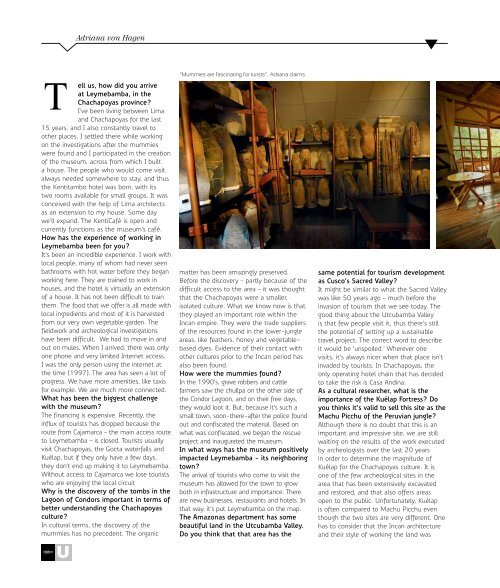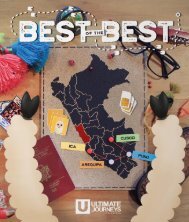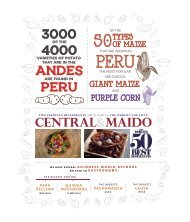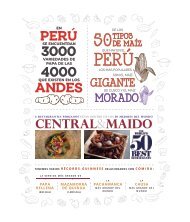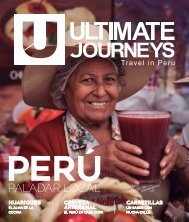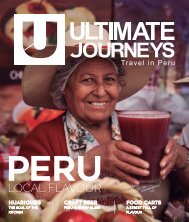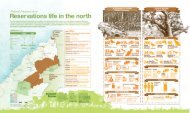UJ #3 - Peru: A luxury destination
You also want an ePaper? Increase the reach of your titles
YUMPU automatically turns print PDFs into web optimized ePapers that Google loves.
Adriana von Hagen<br />
T<br />
ell us, how did you arrive<br />
at Leymebamba, in the<br />
Chachapoyas province?<br />
I’ve been living between Lima<br />
and Chachapoyas for the last<br />
15 years, and I also constantly travel to<br />
other places. I settled there while working<br />
on the investigations after the mummies<br />
were found and I participated in the creation<br />
of the museum, across from which I built<br />
a house. The people who would come visit<br />
always needed somewhere to stay, and thus<br />
the Kentitambo hotel was born, with its<br />
two rooms available for small groups. It was<br />
conceived with the help of Lima architects<br />
as an extension to my house. Some day<br />
we’ll expand. The KentiCafé is open and<br />
currently functions as the museum’s café.<br />
How has the experience of working in<br />
Leymebamba been for you?<br />
It’s been an incredible experience. I work with<br />
local people, many of whom had never seen<br />
bathrooms with hot water before they began<br />
working here. They are trained to work in<br />
houses, and the hotel is virtually an extension<br />
of a house. It has not been difficult to train<br />
them. The food that we offer is all made with<br />
local ingredients and most of it is harvested<br />
from our very own vegetable garden. The<br />
fieldwork and archeological investigations<br />
have been difficult. We had to move in and<br />
out on mules. When I arrived, there was only<br />
one phone and very limited Internet access.<br />
I was the only person using the internet at<br />
the time (1997). The area has seen a lot of<br />
progress. We have more amenities, like taxis<br />
for example. We are much more connected.<br />
What has been the biggest challenge<br />
with the museum?<br />
The financing is expensive. Recently, the<br />
influx of tourists has dropped because the<br />
route from Cajamarca – the main access route<br />
to Leymebamba – is closed. Tourists usually<br />
visit Chachapoyas, the Gocta waterfalls and<br />
Kuélap, but if they only have a few days,<br />
they don’t end up making it to Leymebamba.<br />
Without access to Cajamarca we lose tourists<br />
who are enjoying the local circuit<br />
Why is the discovery of the tombs in the<br />
Lagoon of Condors important in terms of<br />
better understanding the Chachapoyas<br />
culture?<br />
In cultural terms, the discovery of the<br />
mummies has no precedent. The organic<br />
“Mummies are fascinating for turists”, Adriana claims.<br />
matter has been amazingly preserved.<br />
Before the discovery – partly because of the<br />
difficult access to the area – it was thought<br />
that the Chachapoyas were a smaller,<br />
isolated culture. What we know now is that<br />
they played an important role within the<br />
Incan empire. They were the trade suppliers<br />
of the resources found in the lower-jungle<br />
areas, like feathers, honey and vegetablebased<br />
dyes. Evidence of their contact with<br />
other cultures prior to the Incan period has<br />
also been found.<br />
How were the mummies found?<br />
In the 1990’s, grave robbers and cattle<br />
farmers saw the chullpa on the other side of<br />
the Condor Lagoon, and on their free days,<br />
they would loot it. But, because it’s such a<br />
small town, soon-there-after the police found<br />
out and confiscated the material. Based on<br />
what was confiscated, we began the rescue<br />
project and inaugurated the museum.<br />
In what ways has the museum positively<br />
impacted Leymebamba - its neighboring<br />
town?<br />
The arrival of tourists who come to visit the<br />
museum has allowed for the town to grow<br />
both in infrastructure and importance. There<br />
are new businesses, restaurants and hotels. In<br />
that way, it’s put Leymebamba on the map.<br />
The Amazonas department has some<br />
beautiful land in the Utcubamba Valley.<br />
Do you think that that area has the<br />
same potential for tourism development<br />
as Cusco’s Sacred Valley?<br />
It might be similar to what the Sacred Valley<br />
was like 50 years ago – much before the<br />
invasion of tourism that we see today. The<br />
good thing about the Utcubamba Valley<br />
is that few people visit it, thus there’s still<br />
the potential of setting up a sustainable<br />
travel project. The correct word to describe<br />
it would be ‘unspoiled.’ Wherever one<br />
visits, it’s always nicer when that place isn’t<br />
invaded by tourists. In Chachapoyas, the<br />
only operating hotel chain that has decided<br />
to take the risk is Casa Andina.<br />
As a cultural researcher, what is the<br />
importance of the Kuélap Fortress? Do<br />
you thinks it’s valid to sell this site as the<br />
Machu Picchu of the <strong>Peru</strong>vian jungle?<br />
Although there is no doubt that this is an<br />
important and impressive site, we are still<br />
waiting on the results of the work executed<br />
by archeologists over the last 20 years<br />
in order to determine the magnitude of<br />
Kuélap for the Chachapoyas culture. It is<br />
one of the few archeological sites in the<br />
area that has been extensively excavated<br />
and restored, and that also offers areas<br />
open to the public. Unfortunately, Kuélap<br />
is often compared to Machu Picchu even<br />
though the two sites are very different. One<br />
has to consider that the Incan architecture<br />
and their style of working the land was<br />
36


